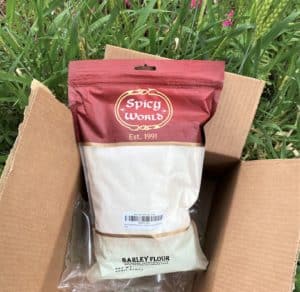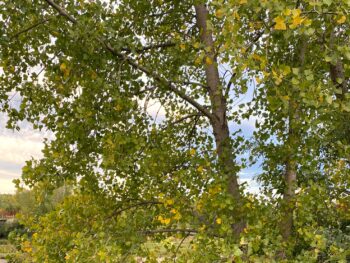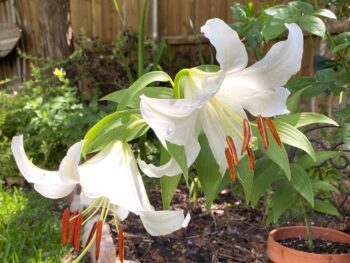Growing barley is nothing short of a true delight! This humble, easy-to-cultivate annual grass will flourish in your garden with few demands, and its standing in Scripture will draw you to some of the most intricate revelations of the Lord Jesus.
Barley serves our gardens as a bridge plant between winter’s bareness and spring’s waking warm-up. Likewise, its mention in the Bible bridges the vast expanse from God to His people—quite an epic appointment for an unassuming grain!
New to the Plant guide – Barley, Hordeum vulgare, an Edible Annual
Growing Barley
Barley seed sprouts easily; depending on your climate, scatter plentifully late fall or late winter, with no need for thinning seedlings. Moistened grains will sprout in about three days (no surprise for a picturing-Jesus plant!); keep the dirt damp but not too wet until roots are established. Let the cool, seasonal weather do the rest. Did I mention soil preparation? No, because there is none! Barley is not fussy when it comes to soil type, and just a simple raking of the surface to let seeds contact the soil is enough for this ancient grain to take hold.

Seedlings remain about 6 inches tall through the darkest winter days, reminiscent of a lush, vibrant green pasture. They fill in handsomely among perennials dying back in the cold. Come spring, as days lengthen and temperatures rise, so do the stalks, their grainheads emerging to add a distinct texture among waking herbs and woody shrubs. The wispy fruits swagger in spring breezes and wave in blusters of changing weather, the playful reasons grasses have become landscaping favorites.
Finally, as barley fades to drying stalks, surrounding plants have by now filled in; barley has bridged that awkward between-seasons stage and kept your view verdant. Cut stalks for harvest and leave roots to condition the soil with organic matter. While barley must be reseeded annually unlike most ornamental grasses, I have found this to be an appealing quality: each year, as my garden grows and transforms (and as some plants pass on), I find different places among the beds needing patches of barley’s blessing.
Barley & the Spring Feasts
Barley grains’ spring readiness is the backdrop to the Lord’s first appointed meetings with his people.
Can you imagine your barley plot as a place to meet God?
The Feast of Unleavened Bread, proceeded by Passover, Pesach, the eventful eve commemorating the Israelites’ hasty deliverance from slavery in Egypt, marked the first month and designated time in the year to meet with the Lord.
These are the feasts of the Lord, holy convocations which you shall proclaim at their appointed times. On the fourteenth day of the first month at twilight is the Lord’s Passover. And on the fifteenth day of the same month is the Feast of Unleavened Bread to the Lord; seven days you must eat unleavened bread.
Leviticus 23:4-6 NKJV
Men from every household went up to the Temple in Jerusalem to assemble, instructed to bring the first sheaf or omer (about 3 ½ cups of grain seed) of their barley crop to the priest to make a wave offering:
And the Lord spoke to Moses, saying, “Speak to the children of Israel, and say to them: ‘When you come into the land which I give to you, and reap its harvest, then you shall bring a sheaf of the firstfruits of your harvest to the priest. He shall wave the sheaf before the Lord, to be accepted on your behalf; on the day after the Sabbath the priest shall wave it.
Leviticus 23:9-11 NKJV
The Unleavened Bread Feast was a 7 day engagement to eat bread without yeast, symbolizing the need to be purified from the world’s polluting ways. The wave offering would occur “the day after the Sabbath,” or the Sunday that fell during these 7 days, acknowledging the Lord’s bountiful provision to their families with the “firstfruits” of their crop—barley would be the first crop ready for harvest at this time.

Though the prescription for celebrating these feasts was given with the Torah in the Sinai Desert, it foretold the day when Jesus would deliver all from death’s bondage and rise up as “Firstfruits.”
But the fact is that the Messiah has been raised from the dead, the firstfruits of those who have died. For since death came through a man, also the resurrection of the dead has come through a man. For just as in connection with Adam all die, so in connection with the Messiah all will be made alive. But each in his own order: the Messiah is the firstfruits; then those who belong to the Messiah, at the time of his coming…
1 Corinthians 15:20-23 CJB
Linger for a moment in the astounding view of history that God knew from beginning to end exactly how He would meet all our needs. The Hebrew word for “appointed time,” or feast as it is usually translated, is moed, the same word used to describe the purpose of the sun and moon, which in turn measure the months that alerted His people to the time to meet Him through the feasts.
And God said, “Let there be lights in the vaulted dome of heaven to separate day from night, and let them be as signs and for appointed times [moed], and for days and years, and they shall be as lights in the vaulted dome of heaven to give light on the earth.” And it was so.
Genesis 1:14-15 LEB
From earth’s creation, God has been mindful of timing and preparing our time with Him. Likewise, Jesus was in concert with God the Father’s timing:
From that time, Jesus began to show his disciples that he had to go to Jerusalem and suffer many things from the elders, chief priests, and experts in the law, and be killed, and on the third day be raised again. Matthew 16:21 EHV
You go up to the festival. I am not going up to this festival yet, because the right time for me has not yet arrived.” John 7:6 EHV
Before the Passover Festival, Jesus knew that the time had come for him to leave this world and go to the Father. John 13:1 EHV
Yes, I choose the appointed time. I am the one who judges rightly. Psalm 75:2 EHV
We were living against God, but at the right time, Christ died for us. Romans 5:6 ICB
Counting the Omer
There is even a feast about timing! From this barley offering, or omer , the Israelites were to count the days, and let the days become weeks, let the weeks become 7, and then meet again the day after for the next feast, Feast of Weeks or Shavuot.
Then from the day after the Sabbath, from the day that you bring the sheaf to be waved, you shall count off seven weeks for yourselves. They must be complete weeks. You shall count fifty days, until you reach the day after the seventh Sabbath. Then you shall present an offering of new grain to the Lord.
Leviticus 23:15-16 EHV
You are to count seven weeks; you are to begin counting seven weeks from the time you first put your sickle to the standing grain. You are to observe the festival of Shavu‘ot [weeks] for Adonai your God with a voluntary offering…
Deuteronomy 16:9-10 CJB
Counting the Omer, Sfirat HaOmer, is a beautiful practice in the Jewish faith today. Enjoy this insight eloquently offered by my Instagram friend @ritainspired:
…When one looks forward to a significant day one counts off the days remaining between the present and that day. Why then do we count the days which have elapsed from Pessach? Surely we should be counting the diminishing number of days which have passed? The fact is that Sefirat Ha Omer we count up- one day of the Omer, two days of the Omer, and so on. Why? Counting in Torah terms is not a sentimental marking of the passage of time until a goal; it is the building of that goal. Counting is work. Counting means accounting for and enveloping each component of a process fully, responsibly, and in correct sequence. Only when each detail is painstakingly created and assembled into the process can the goal be reached- in fact that itself is the goal; the sequence is our responsibility, if done correctly, the goal certainly results.
— Rita Benisti, @ritainspired on Instagram April 6th, 2021, quoting from Living Inspired, by Rabbi Akiva Tatz
Building up from the barley offering is a practice of continuing to walk in God’s Way; that is, to live out the freedom He has won for us in His Firstfruits Resurrection. All of the supernatural events of both liberations—the plagues, passing over of the angel of death, escape on dry ground through the Reed Sea, miraculous healings, unjust death of crucifixion, rising from death—must find their place little by little, step by step, day by day in the way that we live. Jesus knew the work ahead of us, to knead His provision into the routine of our everyday, and so He equipped us with a prayer:
Give us this day our daily bread
Luke 11:3
…which brings us back to barley!
Growing Barley & Bread of Heaven

Jesus displayed his godly power through a few loaves of barley bread, don’t you love His garden details?! Keep in mind this was just before Passover, when barley grainheads throughout the land would be fully formed and stirring in spring breezes—what a background!
One of the disciples—it was Andrew, brother to Simon Peter—said, “There’s a little boy here who has five barley loaves and two fish. But that’s a drop in the bucket for a crowd like this.” Jesus said, “Make the people sit down.” There was a nice carpet of green grass in this place. They sat down, about five thousand of them. Then Jesus took the bread and, having given thanks, gave it to those who were seated. He did the same with the fish. All ate as much as they wanted. When the people had eaten their fill, he said to his disciples, “Gather the leftovers so nothing is wasted.” They went to work and filled twelve large baskets with leftovers from the five barley loaves.
John 6:8-13 The Message
This supernatural provision would capture his disciples’ attention with a measure of the first Passover’s miraculous fanfare, yet it was purposed to bring the discussion around to the more intimate matter of sustenance, with bread as the bridge. He was passing on an intimate understanding that our spiritual relationship with God will grow and supplant our hunger for physical nourishment.
Ironically, the disciples pestered Jesus about Moses and manna, the bread of heaven, precisely the place where Jesus was ready build their understanding.
Jesus responded, “The real significance of that Scripture is not that Moses gave you bread from heaven but that my Father is right now offering you bread from heaven, the real bread. The Bread of God came down out of heaven and is giving life to the world.” They jumped at that: “Master, give us this bread, now and forever!” Jesus said, “I am the Bread of Life. The person who aligns with me hungers no more and thirsts no more, ever. I have told you this explicitly because even though you have seen me in action, you don’t really believe me.
John 6:33-37 The Message
Imagine the Lord speaking these words, and the disciples’ pause and ponder of what He was saying, grasping for belief. Now consider this confession in the context of these Scriptures previously spoken:
…one does not live by bread alone, but by every word that comes from the mouth of the Lord. Deuteronomy 8:3 NRSV

And the Word was made flesh, and dwelt among us. John 1:14 KJV
There is much here to digest, the spiritual relationship between bread, God’s Word, and Jesus. Hmmm. I don’t have any more to offer except that we are beholding deep mysteries, which are inimitably beautiful….there is a belief threshold to cross….and I want to go bake barley bread!
Prayer: My dear Lord Jesus, the mysteries of your Word thrill me even as they find me dumbfounded at their magnificent convergence. These are epic revelations for my simple day—I don’t know what to say! But I am so grateful to know you, behold you, and be with you in little ways like growing barley. Thank you for all that You provide for me, and the death you died to set me free. Let my garden continue to prompt me to meet you and ponder your Words.
Every person the Father gives me eventually comes running to me. And once that person is with me, I hold on and don’t let go.
John 6:38 The Message

For a thorough, extraordinary explanation of the significance of the Jewish Feasts, visit The Seven Feasts of Israel – Introduction at www.blogs.bible.org – many thanks for this tremendous resource and inspiration!

Barley joins the plant guide! Read more information about growing barley in your garden at www.gardenindelight.com/plant-guide/barley/

Read more about barley in God’s Word for Gardeners Bible, in the Sowing & Reaping series of devotions beginning on page a-31

For deeper dig into growing barley and other grains, read Brie Arthur’s Gardening with Grains (Pittsburgh: St. Lynn’s Press, 2019) for sale at Book Shop — Brie Grows or www.briegrows.com/shop & read my review at Ezekiel’s Ancient Grains – Garden In Delight
CJB notes Scripture quotations taken from the Complete Jewish Bible by David H. Stern. Copyright © 1998. All rights reserved. Used by permission of Messianic Jewish Publishers, 6120 Day Long Lane, Clarksville, MD 21029. www.messianicjewish.net.
EHV notes Scripture quotations taken from The Holy Bible, Evangelical Heritage Version® , EHV®, © 2019 Wartburg Project, Inc. All rights reserved. Used by permission.
ICB denotes Scriptures taken from the International Children’s Bible®, copyright ©1986, 1988, 1999, 2015 by Thomas Nelson. Used by permission. All rights reserved.
KJV denotes Scriptures taken from The Holy Bible, King James Version published in 1611, authorized by King James I of England, which is public domain in the United States.
LEB denotes Scripture quotations taken from the Lexham English Bible. Copyright 2012 Logos Bible Software. Lexham is a registered trademark of Logos Bible Software.
MSG or The Message denotes Scripture quotations taken from THE MESSAGE, copyright © 1993, 2002, 2018 by Eugene H. Peterson. Used by permission of NavPress. All rights reserved. Represented by Tyndale House Publishers, a Division of Tyndale House Ministries.NKJV denotes Scripture taken from the New King James Version®. Copyright © 1982 by Thomas Nelson. Used by permission. All rights reserved.
NRSV denotes Scripture quotations taken from the New Revised Standard Version Bible, copyright © 1989 the Division of Christian Education of the National Council of the Churches of Christ in the United States of America. Used by permission. All rights reserved.













